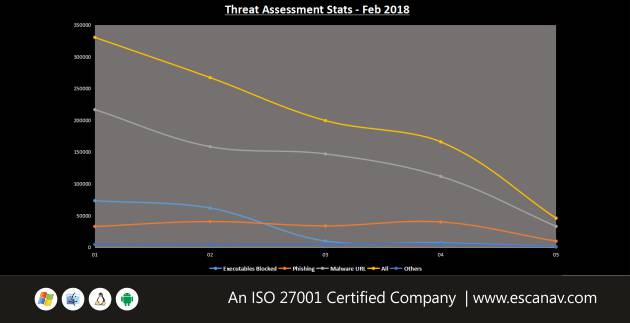The first Ransomware report of February 2018 highlights the details of the attacks happened during the week by-gone. It not only gives the details of ransomware threat figures but also warns us about phishing attacks, malware URLs, and other dangerous executables. The threat parameters varied from period to period and eScan has successfully tracked it with the help of server hits.
The growth of targeted attacks
eScan researchers have found the emerging trend of ransomware. In the above image, we can see a declining trend in the attacks in the week and the trend shows more possibility of ransomware attack on the system resulting in disastrous consequences. The number of attacks was on the higher side in the beginning of the week which declined gradually towards the end. Now, the analysis of the below report attempts to assess the scale of the problem and highlights the periods when the ransomware invasions were maximum.

Ransomware invasion on the networks is happening every now and then. The hourly record of ransomware attack gives knowledge of how frequently it is searching for vulnerable areas where it can attack for encryption activities. There is a slight fluctuation in the middle of the week and helps to access the organizations to take extra preventive measures round the clock to avoid any major loss.

Solutions
- Update your antivirus software on regular basis, which will protect your system from all kinds of Malware attacks.
- Always download apps from their official website or Google Play Store instead of unknown sources because many apps store are still offering the app.
- Download applications of a reliable app developer. In addition, check the user ratings and reviews of the app before download.
- Ensure that all the software installed in your system is updated frequently, including Oracle Java and Adobe.
- Implement a three-dimensional security policy in your organization, i.e. firstly understand your requirement based on which IT Security policy would be prepared accordingly. Secondly, educate your staff about the policy and finally enforce the policy.
- Make sure you either implement MailScan at gateway level or enable Mail Anti-virus on the endpoint in order to block extensions such as *.EXE, *.SCR, *.JS, *.VBE etc. These attachments would infect your system.
- Open emails only if you are positive about the source.
- Regularly create backup of your important files.







